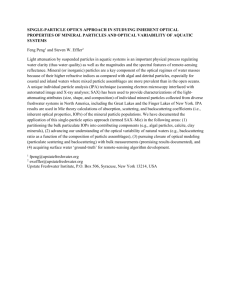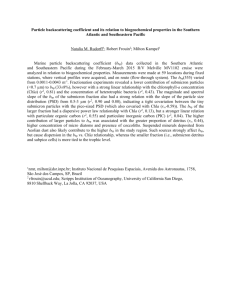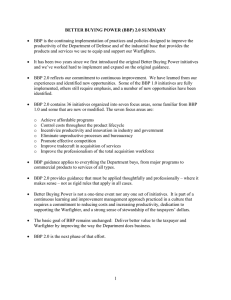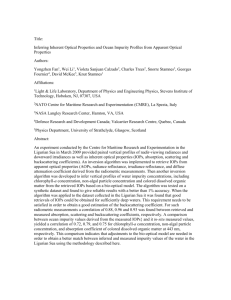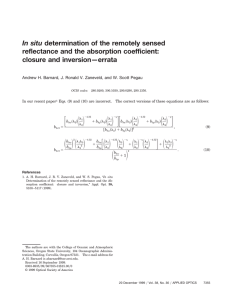Effects of bulk particle characteristics on backscattering and optical closure Grace Chang
advertisement
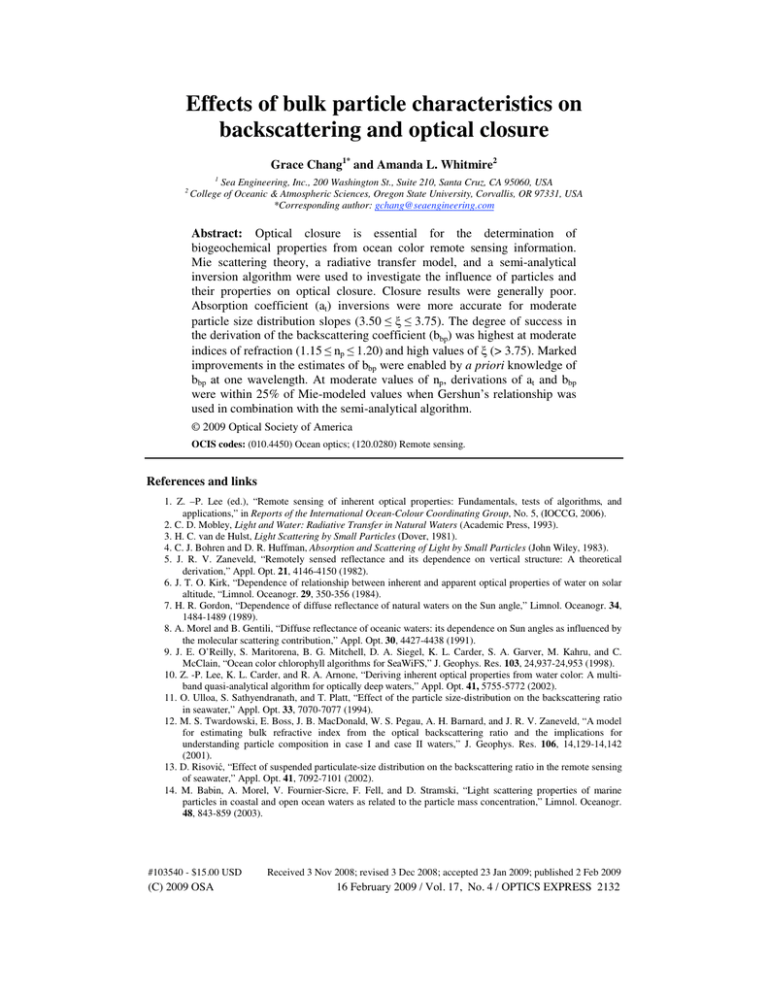
Effects of bulk particle characteristics on
backscattering and optical closure
Grace Chang1* and Amanda L. Whitmire2
2
1
Sea Engineering, Inc., 200 Washington St., Suite 210, Santa Cruz, CA 95060, USA
College of Oceanic & Atmospheric Sciences, Oregon State University, Corvallis, OR 97331, USA
*Corresponding author: gchang@seaengineering.com
Abstract: Optical closure is essential for the determination of
biogeochemical properties from ocean color remote sensing information.
Mie scattering theory, a radiative transfer model, and a semi-analytical
inversion algorithm were used to investigate the influence of particles and
their properties on optical closure. Closure results were generally poor.
Absorption coefficient (at) inversions were more accurate for moderate
particle size distribution slopes (3.50 3.75). The degree of success in
the derivation of the backscattering coefficient (bbp) was highest at moderate
indices of refraction (1.15 np 1.20) and high values of (> 3.75). Marked
improvements in the estimates of bbp were enabled by a priori knowledge of
bbp at one wavelength. At moderate values of np, derivations of at and bbp
were within 25% of Mie-modeled values when Gershun’s relationship was
used in combination with the semi-analytical algorithm.
© 2009 Optical Society of America
OCIS codes: (010.4450) Ocean optics; (120.0280) Remote sensing.
References and links
1. Z. –P. Lee (ed.), “Remote sensing of inherent optical properties: Fundamentals, tests of algorithms, and
applications,” in Reports of the International Ocean-Colour Coordinating Group, No. 5, (IOCCG, 2006).
2. C. D. Mobley, Light and Water: Radiative Transfer in Natural Waters (Academic Press, 1993).
3. H. C. van de Hulst, Light Scattering by Small Particles (Dover, 1981).
4. C. J. Bohren and D. R. Huffman, Absorption and Scattering of Light by Small Particles (John Wiley, 1983).
5. J. R. V. Zaneveld, “Remotely sensed reflectance and its dependence on vertical structure: A theoretical
derivation,” Appl. Opt. 21, 4146-4150 (1982).
6. J. T. O. Kirk, “Dependence of relationship between inherent and apparent optical properties of water on solar
altitude, “Limnol. Oceanogr. 29, 350-356 (1984).
7. H. R. Gordon, “Dependence of diffuse reflectance of natural waters on the Sun angle,” Limnol. Oceanogr. 34,
1484-1489 (1989).
8. A. Morel and B. Gentili, “Diffuse reflectance of oceanic waters: its dependence on Sun angles as influenced by
the molecular scattering contribution,” Appl. Opt. 30, 4427-4438 (1991).
9. J. E. O’Reilly, S. Maritorena, B. G. Mitchell, D. A. Siegel, K. L. Carder, S. A. Garver, M. Kahru, and C.
McClain, “Ocean color chlorophyll algorithms for SeaWiFS,” J. Geophys. Res. 103, 24,937-24,953 (1998).
10. Z. -P. Lee, K. L. Carder, and R. A. Arnone, “Deriving inherent optical properties from water color: A multiband quasi-analytical algorithm for optically deep waters,” Appl. Opt. 41, 5755-5772 (2002).
11. O. Ulloa, S. Sathyendranath, and T. Platt, “Effect of the particle size-distribution on the backscattering ratio
in seawater,” Appl. Opt. 33, 7070-7077 (1994).
12. M. S. Twardowski, E. Boss, J. B. MacDonald, W. S. Pegau, A. H. Barnard, and J. R. V. Zaneveld, “A model
for estimating bulk refractive index from the optical backscattering ratio and the implications for
understanding particle composition in case I and case II waters,” J. Geophys. Res. 106, 14,129-14,142
(2001).
13. D. Risovi, “Effect of suspended particulate-size distribution on the backscattering ratio in the remote sensing
of seawater,” Appl. Opt. 41, 7092-7101 (2002).
14. M. Babin, A. Morel, V. Fournier-Sicre, F. Fell, and D. Stramski, “Light scattering properties of marine
particles in coastal and open ocean waters as related to the particle mass concentration,” Limnol. Oceanogr.
48, 843-859 (2003).
#103540 - $15.00 USD
(C) 2009 OSA
Received 3 Nov 2008; revised 3 Dec 2008; accepted 23 Jan 2009; published 2 Feb 2009
16 February 2009 / Vol. 17, No. 4 / OPTICS EXPRESS 2132
15. E. Boss, W. S. Pegau, M. Lee, M. S. Twardowski, E. Shybanov, G. Korotaev, and F. Baratange, “The
particulate backscattering ratio at LEO-15 and its use to study particle composition and distribution,” J.
Geophys. Res. 109, C1, C0101410.1029/2002JC001514 (2004).
16. E. Boss, D. Stramski, T. Bergmann, W. S. Pegau, and M. Lewis, “Why Should We Measure the Optical
Backscattering Coefficient?” Oceanography 17, 44-49 (2004).
17. S. B. Wozniak and D. Stramski, “Modeling the optical properties of mineral particles suspended in seawater
and their influence on ocean reflectance and chlorophyll estimation from remote sensing algorithms,” Appl.
Opt. 43, 3489-3503 (2004).
18. J. M. Sullivan, M. S. Twardowski, P. L. Donaghay, and S. Freeman, “Use of optical scattering to discriminate
particle types in coastal waters,” Appl. Opt. 44, 1667-1680 (2005).
19. A. L. Whitmire, E. Boss, T. J. Cowles, and W. S. Pegau, “Spectral variability of the particulate backscattering
ratio,” Opt. Express 15, 7019-7031 (2007).
20. W. A. Snyder, R. A. Arnone, C. O. Davis, W. Goode, R. W. Gould, S. Ladner, G. Lamela, W. J. Rhea, R.
Stavn, M. Sydor, and A. Weidemann, “Optical scattering and backscattering by organic and inorganic
particles in U.S. coastal waters,” Appl. Opt. 47, 666-677 (2008).
21. G. C. Chang, A. H. Barnard, S. McLean, P. J. Egli, C. Moore, J. R. V. Zaneveld, T. D. Dickey, and A.
Hanson, “In situ optical variability and relationships in the Santa Barbara Channel: implications for remote
sensing,” Appl. Opt. 45, 3593-3604 (2006).
22. G. Chang, A. H. Barnard, and J. R. V. Zaneveld, “Optical closure in a complex coastal environment: Particle
effects,” Appl. Opt. 46, 7679-7692 (2007).
23. D. Stramski, A. Morel, and A. Bricaud, “Modeling the light attenuation and scattering by spherical
phytoplankton cells: A retrieval of the bulk refractive index,” Appl. Opt. 27, 3954-3956 (1988).
24. D. R. Lide, “Physical and optical properties of minerals,” in CRC Handbook of Chemistry and Physics, 77th
ed., D. R. Lide, ed. (CRC Press, 1997), pp. 4130-4136.
25. E. Boss, M. S. Twardowski, and S. Herring, “Shape of the particulate beam attenuation spectrum and its
inversion to obtain the shape of the particulate size distribution,” Appl. Opt. 40, 4885-4893 (2001).
26. H. R. Gordon, O. B. Brown, R. H. Evans, J. W. Brown, R. C. Smith, K. S. Baker, and D. K. Clark, “A
semianalytic radiance model of ocean color,” J. Geophys. Res. 93, 10,909-10,924 (1988).
27. A. Bricaud, A. Morel and L. Prieur, “Optical efficiency factors of some phytoplankters,” Limnol. Oceanogr.
28, 816-832 (1983).
28. A. Bricaud. and A. Morel, “Light attenuation and scattering by phytoplanktonic cells: a theoretical
modeling,” Appl. Opt. 25, 571-580 (1986).
29. Y.-H. Ahn, A. Bricaud, and A. Morel, “Light backscattering efficiency and related properties of some
phytoplankters,” Deep Sea Res. 39, 1835-1855 (1992).
30. D. Stramski, A. Bricaud, and A. Morel, “Modeling the inherent optical properties of the ocean based on the
detailed composition of planktonic community,” Appl. Opt. 40, 2929-2945 (2001).
31. A. L. Whitmire, The spectral backscattering properties of marine particles, Ph.D. dissertation, Oregon State
University, 2008. ScholarsArchive@OSU, 28 Oct. 2008 <http://hdl.handle.net/1957/9088>.
32. A. Morel and A. Bricaud, "Theoretical results concerning the optics of phytoplankton, with special Reference
to remote sensing applications," in Oceanography from Space, J. F. R. Gower, Ed. (Plenum, New York,
1981).
33. C. D. Mobley, L. K. Sundman, and E. Boss, “Phase function effects on oceanic light fields,” Appl. Opt. 41,
1035-1050 (2002).
34. H. Loisel, X. Mériaux, J-F. Berthon, and A. Poteau, “Investigation of the optical backscattering to scattering
ratio of marine particles in relation to their biogeochemical composition in the eastern English Channel and
southern North Sea,” Limnol. Oceanogr. 52(2), 739-752 (2007).
35. A. Morel, K. J. Voss, and B. Gentili, “Bidirectional reflectance of oceanic waters: A comparison of modeled
and measured upward radiance fields,” J. Geophys. Res. 100, 13,143-13,150 (1995).
36. H. Loisel and A. Morel, “Non-isotropy of the upward radiance field in typical coastal (Case 2) waters,” Int. J.
Remote Sens. 22, 275-295 (2001).
37. J. R. V. Zaneveld, “A theoretical derivation of the dependence of the remotely sensed reflectance of the ocean
on the inherent optical properties,” J. Geophys. Res. 100, 13,135-13,142 (1995).
38. Y. Park and K. Ruddick, “Model of remote-sensing reflectance including bi-directional effects for case 1 and
case 2 waters,” Appl. Opt. 44, 1236-1249 (2005).
39. A. Morel and S. Maritorena, “Bio-optical properties of oceanic waters: A reappraisal,” J. Geophys. Res. 106,
7163-7180 (2001).
1. Introduction
Optical closure involves solutions to the forward and inverse problems in ocean optics. Both
problems are twofold: Forward – the determination of the inherent optical properties (IOPs)
from characteristics of the particulate and dissolved material and the prediction of the
apparent optical properties (AOPs) from the IOPs; Inverse – the derivation of the IOPs from
the AOPs, and the determination of biogeochemical properties from the IOPs. The latter
#103540 - $15.00 USD
(C) 2009 OSA
Received 3 Nov 2008; revised 3 Dec 2008; accepted 23 Jan 2009; published 2 Feb 2009
16 February 2009 / Vol. 17, No. 4 / OPTICS EXPRESS 2133
component of the inverse problem is especially important for interpretation of ocean color
remote sensing data to synoptically observe and monitor interdisciplinary processes such as
biogeochemical cycling, particle transport, and ecosystem dynamics (e.g., see [1]). Other than
the computation of the AOPs from the IOPs, i.e. component #2 of the forward problem [2],
optical closure has proven problematic – particularly for global scale applications.
Optical theory suggests that the optical properties of particles depend on characteristics
such as particle size, shape, composition, and index of refraction [3,4]. Mie scattering theory
involves the estimation of the IOPs from characteristics for a single particle or a population of
mono-dispersed or poly-dispersed particles. Briefly, Mie theory determines the scattering and
extinction efficiency factors (and absorption by difference) for a homogeneous sphere at a
given wavelength, index of refraction, and particle diameter. Ensembles of efficiency factors
for spheres of different sizes can then be applied, using a specified particle size distribution
(PSD) and number concentration to derive the respective IOPs, i.e. the absorption, scattering,
and attenuation coefficients for a particle population.
The IOPs are in turn directly related to remote sensing reflectance through radiative
transfer theory, which can be numerically modeled (e.g., [2]). A simpler approach to radiative
transfer has been proposed, with remote sensing reflectance correlated to the absorption and
backscattering coefficients and represented by:
rrs() [f() / Q()] { bbt() / [at() + bbt()] },
(1)
where bbt() is total spectral backscattering, at() is total spectral absorption, and the f/Q ratio
(wavelength notation hereafter suppressed) is a parameter that depends on the shape of the
upwelling light field and the volume scattering function (VSF) [5]. The parameter Q() is a
measurable quantity: the ratio of upwelling irradiance to upwelling radiance. However the
value, f(), is often approximated for a single VSF [6] or using assumed scattering properties
and sky conditions [7,8], which oftentimes leads to erroneous computations of rrs() from the
IOPs and vice versa when inverting this relationship (i.e. the inverse problem).
Empirical and semi-analytical algorithms have been developed to invert remote sensing
reflectance signals to obtain the IOPs and biogeochemical constituents (e.g., chlorophyll
concentration; [9]). Empirical algorithms have proven challenging for Case II waters, whose
optical properties are not dominated by chlorophyll-containing particles but rather by
inorganic particles, colored dissolved organic matter (CDOM), or both quantities. Semianalytical algorithms based on Eq. (1) (e.g., see [10]) have been more successful when applied
to widely varying optical water types, however, assumptions about the spectral and angular
scattering properties and the upwelling light field can negatively impact inversion results.
The effects of particles and particle characteristics on the variability of remote sensing
reflectance need to be understood in order to solve the forward and inverse problems in ocean
optics and importantly, to better utilize ocean color data to obtain information about
biogeochemistry and ecosystem dynamics. We present results from forward and backward
approaches to optical closure with emphasis on the effects of particles and their characteristics
on backscattering, the backscattering ratio, and ocean color. We build upon decades of
theoretical, laboratory, and field results (e.g., see [3,4,11-20]).
2. Methods
Mie scattering theory and the radiative transfer model, Hydrolight, were used to compute the
bulk IOPs and AOPs for a set of hypothetical water masses containing particle populations
with variable bulk indices of refraction and PSDs. The influence of particles and their
properties (e.g., bulk real index of refraction and PSD slope, np and , respectively) on the
IOPs and AOPs and on inversion algorithms to derive the IOPs from AOPs was investigated
using a semi-analytical remote sensing inversion algorithm.
#103540 - $15.00 USD
(C) 2009 OSA
Received 3 Nov 2008; revised 3 Dec 2008; accepted 23 Jan 2009; published 2 Feb 2009
16 February 2009 / Vol. 17, No. 4 / OPTICS EXPRESS 2134
2.1 Forward approach
Mie scattering theory was used to generate bulk IOPs for a series of hypothetical water
masses. Mie model input values were determined based on four years of time series
measurements of optical properties collected on a mooring at 4 m water depth in shallow
coastal waters of the Santa Barbara Channel (Fig. 1). Optical water types in this region of the
Santa Barbara Channel are highly biogeochemically complex and can vary rapidly from
relatively clear waters dominated by biogenic particles to very turbid and comprised of mostly
inorganic particles [21,22].
We used the Mie code provided by Bohren and Huffman [4] for scattering by
homogeneous spheres (routines BHMIE and CALLBH), translated from Fortran language into
Matlab by E. Boss (U Maine). This code computes the elements and efficiencies of the
amplitude scattering matrix. The modeled PSDs were restricted to a size range of diameters,
D, ranging from 0.2 – 100 m in 35 logarithmically spaced size bins. The PSDs followed a
differential size distribution function where f(D) = N x D-, where N is the particle
concentration (held constant at 5 x 105 mL-1), i.e. we assumed Junge-type PSDs. We used np
values of 1.01, 1.05, 1.10, 1.15 and 1.20 and values of 3.0, 3.25, 3.5, 3.75, 4.0 and 4.25 at
nine wavelengths (= 412, 440, 488, 510, 532, 555, 650, 676, and 715 nm). The imaginary
index of refraction of particles was held constant at n’ = 0.01 for all Mie theory calculations.
Flatter PSD slopes, i.e. lower values of generally imply more large particles are present in a
population, whereas steeper PSD slopes specify smaller particles. Lower values of np are
indicative of biological particles (npphytoplankton = 1.02 – 1.07; [23]) because of their high water
content, and minerogenic particles are represented by higher values of np (npminerogenic = 1.14 to
1.26; [24]). Two hundred and seventy sets of IOPs were determined from Mie modeling
efforts. These Mie-computed IOPs were within the range of IOPs measured in the Santa
Barbara Channel (Fig. 1).
Fig. 1. Measured IOPs (Santa Barbara Channel). Thick black lines indicate the spectral mean
and dashed black lines denote one standard deviation from the mean. The lower right-hand
panel shows a data series of bulk np (red) and (blue) computed using measured IOPs and
methods presented by Boss et al. [25] and Twardowski et al. [12]. [The IOP property subscript
‘p’ denotes particulate material and ‘g’ represents dissolved matter.]
#103540 - $15.00 USD
(C) 2009 OSA
Received 3 Nov 2008; revised 3 Dec 2008; accepted 23 Jan 2009; published 2 Feb 2009
16 February 2009 / Vol. 17, No. 4 / OPTICS EXPRESS 2135
Phase functions, together with Mie-computed scattering and attenuation (and absorption
by difference) coefficients, were then inputted into the numerical radiative transfer model,
Hydrolight, to compute the AOPs at the surface, just below the surface, and at 4 m geometric
water depth in optically deep waters. Particle phase functions were generated from Miecalculated VSFs using relevant phase function discretization operations in Hydrolight.
Inelastic scattering processes were not included in computations and the following
environmental conditions were assumed: wind speed = 5 m s-1, solar angle = 30°, and 0%
cloud cover. Hydrolight calculations resulted in 270 arrays of AOPs representing five
different bulk indices of refraction, six different PSD slopes, and nine different wavelengths.
2.2 Inverse approach
We employed a semi-analytical remote sensing inversion algorithm [10] in order to examine
the influence of particles and their properties (np and ) on derivations of the IOPs from
AOPs. This algorithm uses the relationship presented by Gordon et al. [26]:
rrs() = g0 u() + g1 [u()]2
(2a)
u() = bbt() / [at() + bbt()]
(2b)
where
and the g-constants are dependent on the particle phase function, oftentimes represented as g0
= 0.084 and g1 = 0.17 [10], which are the values we used in our computations. Due to the
relatively large values of at(440) (> 0.3 m-1), at(650) was first parameterized as a function of
Hydrolight-derived rrs(), then bbt(650) was derived from Eq. (2), as opposed to using the 555
nm wavelength method [10]. Next, bbt() was computed; it was assumed to monotonically
decrease with increasing wavelength:
bbt() = bbw() + bbp(0) (0/),
(3)
where 0 = 650 nm and is a function of rrs(). Spectral at() was calculated following Eq.
(2). Details regarding empirical parameterizations of the IOPs and rrs() can be found in Lee
et al. [10].
3. Results and discussion
To verify data and model integrity, we provide an independent parameterization of at()
derived from Gershun’s equation. The exact relationship (wavelength notation suppressed):
at = Kd d [1 + R (d/u)]-1 [1 – R + (Kd)-1 dR/dZ],
(4)
(where Kd is the diffuse attenuation coefficient for downwelling irradiance, d and u are the
average cosines for downwelling and upwelling light, respectively, R is irradiance reflectance,
and Z is depth) was applied to our Hydrolight-derived values for Kd, d, u, and R at Z = 4 m.
Comparisons between Mie-modeled absorption coefficients, atMie(), and absorption
coefficients inverted using Gershun’s equation, atGer(), at 4 m are shown in Fig. 2. The exact
1:1 correlation between atMie() and atGer() for all np, , and indicates that no errors were
made in Mie computed inputs to Hydrolight or Hydrolight modeling.
#103540 - $15.00 USD
(C) 2009 OSA
Received 3 Nov 2008; revised 3 Dec 2008; accepted 23 Jan 2009; published 2 Feb 2009
16 February 2009 / Vol. 17, No. 4 / OPTICS EXPRESS 2136
Fig. 2. Comparison between atMie() and atGer() [Eq. (4)] at nine wavelengths, five different
values of np, and six different values of .
3.1 Forward approach - IOPs
The effects of variable np and on spectral IOPs are shown in Fig. 3. The absorption,
attenuation, scattering, and backscattering coefficients (minus water) all increased with
increasing np at all wavelengths. Harder particles (i.e. material with higher np-values) resulted
in higher scattering and less transmission of light, which has been predicted from Mie theory
(e.g., see [11,12]). The absorption coefficient was minimally affected by variations in np and
decreased with increasing ; spectral variability was more or less constant across all np and .
PSD slope effects were similar between cpg() and bp(), i.e. attenuation was controlled more
by scattering processes. In general, cpg() and bp() decreased with increasing but at np >
1.10, cpg() and bp() increased in the blue wavelengths as exceeded 4.0 (Fig. 3). Wozniak
and Stramski [17] also showed higher blue-peaked spectra for mass-specific scattering
coefficients at high values of . Effects of np variability were more pronounced at higher for
cpg() and bp(). This implies that variability in cpg() and bp() was more strongly affected by
the presence of smaller, harder (i.e. minerogenic) particles.
Fig. 3. Spectral IOPs and IOP ratios as a function of np (legend in top left panel; colors
correspond to plot lines and not fill colors) and (x-axes).
#103540 - $15.00 USD
(C) 2009 OSA
Received 3 Nov 2008; revised 3 Dec 2008; accepted 23 Jan 2009; published 2 Feb 2009
16 February 2009 / Vol. 17, No. 4 / OPTICS EXPRESS 2137
Magnitudinal variability in bbp() behaved as expected from Mie theory; bbp() values
increased with increasing np. Increasing from 3.0 to 3.5 resulted in decreased bbp() and then
this trend reversed between = 3.5 and 4.25. Mie-derived backscattering spectral shapes were
not always represented by Eq. (3) and at np > 1.05, bbp() exhibited spectral inflections,
particularly at = 3.0 (Fig. 3). The spectral shape of bbp() became less steep with increasing
np, with the mean power-law exponent changing from = –2.601 to –0.1056, averaged over
six different . The mean of over the 270 Mie-computed bbp() spectra was calculated to be
-0.8991 with a standard deviation of 1.0844. In comparison, Snyder et al. [20] found that the
mean and standard deviation of for over 6000 field measurements of bbp() in coastal waters
was -0.942 ± 0.210. They stated that, “…the spread in this value is not random and represents
small, but real, spectral changes in the backscattering spectral properties of the water” [20].
Their results show that significant departures from the average power-law function occurred
where biological particulates dominated. We also find that the spectral shape of bbp()
deviated from a power-law function at lower np (at np < 1.10, bbp() exponentially decayed
with increasing wavelength; not visible in Fig. 3), which is representative of particles with
higher water content, i.e. biological particles. Spectral inflections in the particulate
backscattering coefficient have been observed in modeling results that used input parameters
based on measurements of phytoplankton cultures [27-30]. Direct measurements of the
spectral backscattering properties of marine phytoplankton cultures have also shown spectral
inflections [31]. Reduced backscattering in spectral regions of strong absorption (e.g. peaks in
absorption by Chlorophyll-a around 440 and 670 nm) is caused by the change in the
imaginary index of refraction at these wavelengths, an effect known as anomalous dispersion
[3,32]. However, spectral inflections present in our results are somewhat surprising, given that
we kept the real and imaginary portions of the index of refraction constant across wavelengths
in our model runs.
Based on theoretical studies [11,12], the backscattering ratio, bbp()/bp(), has
traditionally been assumed to be spectrally flat. However, Ulloa et al. [11] assert that in the
case of monodispersions or in waters dominated by minerogenic particles, bbp()/bp() can
vary strongly with wavelength depending on the size of the particles and their refractive
index. We found that Mie-modeled bbp()/bp() was spectrally flat only at 3.25 for all np,
i.e. larger particles. During all other conditions, bbp()/bp() varied spectrally with increasing
np and . The spectral shape of bbp()/bp() exhibited increasing values with increasing
wavelength, with the steepest spectral slopes observed at = 4.25. The particulate
backscattering ratios observed by Snyder et al. [20] also exhibited a wide range in wavelength
dependence and were highly variable in space and time. However, others have found little
spectral variation in bbp()/bp(). Boss et al. [15] and Mobley et al. [33] reported that
bbp()/bp() spectra varied by less than 10% and 24% for all values of backscattering
measured in coastal New Jersey and modeled using Hydrolight, respectively. Whitmire et al.
[19] found no significant spectral variability in a dataset of over 9000 observations that
included data from diverse aquatic environments and particle populations, with rare
exceptions in instances of monodispersions of large particles. Risovi [13] found that Miemodeled bbp()/bp() was only weakly dependent on wavelength but suggested additional
research on the spectral behavior of bbp()/bp().
Risovi [13] also suggested that bbp()/bp() can be overestimated with Mie theory when
assuming a Junge-type particle distribution. However, our resultant bbp()/bp() values are
quite similar to those measured in the Santa Barbara Channel (Figs. 1 and 3). The magnitude
of bbp()/bp() generally increased with increasing np and , which has been shown by Mie
theory (e.g., Fig. 5 in [11] and Fig. 1 in [12]). Theoretical studies have also indicated that
bbp()/bp() is strongly affected by the presence of sub-micrometer particles and that its
#103540 - $15.00 USD
(C) 2009 OSA
Received 3 Nov 2008; revised 3 Dec 2008; accepted 23 Jan 2009; published 2 Feb 2009
16 February 2009 / Vol. 17, No. 4 / OPTICS EXPRESS 2138
magnitude varies with the slope of the PSD [11]. Observed magnitudinal variability of
bbp()/bp() has been related to particle composition. Loisel et al. [34] indicated that, based on
data collected in European waters, the amount of organic material has a strong influence on
bbp()/bp() and detrital particles resulted in higher values of bbp()/bp(). Boss et al. [15] also
report that bbp()/bp() is strongly related to the index of refraction particles. Snyder et al.
[20], however, do not find any quantifiable evidence of particle type (organic vs. inorganic)
with the magnitude of bbp()/bp() and suggest that other factors need to be considered in
quantifying the variability in bbp()/bp().
The most striking results for the effects of particle characteristics on our set of
hypothetical optical water types was the highly variable spectral shapes of the backscattering
coefficient and the backscattering ratio. Contrary to assumptions made in the past, bbp()/bp()
was not always spectrally flat and spectral bbp() did not always follow the widely used
expression shown in Eq. (3). This suggests that spectral variability, in addition to
magnitudinal variability in bbp()/bp() and bbp() could contain valuable information about
the characteristics of particles. Importantly, variable spectral shapes (e.g., exponential versus
power-law) at low np and spectral inflections at low -values could have profound impacts on
remote sensing and inversion algorithms for the derivation of the IOPs and biogeochemical
properties.
3.2 Forward approach - AOPs
Hydrolight-computed AOP values were within the ranges of those reported in the literature
(Fig. 4). For example, Morel et al. [35] reported field-measured and simulated values of Q()
between 0 and 8 sr and Loisel and Morel [36] found Q() to vary between about 3 and 7 sr
from numerical simulations of case II coastal waters with variable solar angles and scattering
events. Loisel and Morel [36] also reported f/Q values between 0.06 and 0.20 sr-1 for the same
simulations. Kd() values and spectral shapes in Fig. 4 are typical of turbid coastal waters
(e.g., Fig. 2 in [36]).
Fig. 4. 3-D plots of spectral AOPs as a function of np (legend in top left panel; colors
correspond to plot lines and not fill colors) and (x-axes).
Spectral AOPs for variable np and -values are shown in Fig. 4. Kd() behaved similar to
apg(), increasing with increasing np and decreasing with increasing at all wavelengths.
#103540 - $15.00 USD
(C) 2009 OSA
Received 3 Nov 2008; revised 3 Dec 2008; accepted 23 Jan 2009; published 2 Feb 2009
16 February 2009 / Vol. 17, No. 4 / OPTICS EXPRESS 2139
Remote sensing reflectance and R() (irradiance reflectance) spectral effects were as expected
with increasing np and ; spectral shapes shifted from blue-peaked (case I-like) at low np and
to green-peaked (case II-like) at high n and The variability in the f/Q ratio was highly
dependent on wavelength, np, and . The f/Q ratio increased with increasing np at all
wavelengths, however effects of variable were spectrally and np dependent. This suggests
that f/Q is strongly related to scattering processes and should not be treated as a constant (e.g.,
[37,38]) [note that the computation of f assumes that the relationship in Eq. (1) is true]. This
has important implications for inversion algorithms to determine the IOPs and biogeochemical
constituents from remotely sensed ocean color data as many radiative transfer-based inversion
models employ empirically or numerically determined constants in the place of f/Q, e.g., Eqs.
(1) and (2).
3.3 Inverse approach
Absorption and backscattering coefficients derived using a semi-analytical algorithm [10]
were within 150% of “true” values, i.e. Mie-computed (Fig. 5). Lower values of at() were
estimated more accurately than higher values, likely because the algorithm was formulated
based on at() values of less than 0.3 m-1 whereas our Mie-computed at() values were much
higher (mean of 0.5 m-1 at 412 nm; Fig. 1). The degree of success of derivation of at() was
more influenced by as compared to np or wavelength. For derivations of at(), the inversion
algorithm performed best at moderate -values (3.50 3.75) for all values of np and at all
wavelengths. Absorption was slightly overestimated for high values of (i.e. smaller
particles)and underestimated for low (i.e. larger particles). On the other hand, successful
derivations of bbp() were dependent on np and but not necessarily on wavelength or the
magnitude of bbp(). We show that more accurate bbp() estimations were achievable at 1.15
np 1.20 and at higher values of (> 4.0; i.e. smaller particles). Derivations were
underestimated for lower .
Fig. 5. Derived atQAA() and bbpQAA() compared to atMie() and bbpMie(). Wavelengths are
represented by different colors from blue (400 nm range) to red (600 nm range). Open symbols
in the first column denote the different -values (triangles = 3.0, circles = 3.25, squares = 3.50,
pluses = 3.75, stars = 4.0, and asterisks = 4.25) and closed symbols in the second column
represent the different np-values (triangles = 1.01, circles = 1.05, squares = 1.10, crosses = 1.15,
and stars = 1.20).
#103540 - $15.00 USD
(C) 2009 OSA
Received 3 Nov 2008; revised 3 Dec 2008; accepted 23 Jan 2009; published 2 Feb 2009
16 February 2009 / Vol. 17, No. 4 / OPTICS EXPRESS 2140
To investigate potential sources of error in the semi-analytical algorithm for these
particular IOPs and AOPs, we assumed a priori knowledge of bbp(650) and then estimated
bbp() and at() using Eqs. (3) and (2). Results of this exercise are shown in Fig. 6a-d. Not
surprisingly, derivations of spectral bbp() are much more accurate with knowledge of bbp()
at one wavelength (Fig. 6c, d). Other than for np = 1.01, bbp() was generally overestimated,
more so at the blue wavelengths when bbp(650) is known. Thus, at() was also overestimated.
The absorption coefficient was generally overestimated by up to 130%, even at at(650) when
bbp(650) is known, which suggests that g0 and g1 (Eq. 2) are not entirely accurate and should
not be treated as constants, at least for this set of IOPs. This is evidenced by the highly
variable f/Q ratio shown in Fig. 4 and discussed in the previous section.
The right two columns of Fig. 6 (e, f) show derivations of at() using a simplified version
of Eq. (4), where u = 0.40, d = 0.90, and dR/dZ is neglected [39]:
at() = Kd() 0.90 [1 + 2.25 R()]-1 [1 - R()]
(5)
and by assuming R() = 3.5 x rrs(). Eq. (3) was then used to estimate bbp() (Fig. 6g, h). The
use of a simplified Gershun’s equation yielded more accurate derivations of at(), mostly
within 25% of Mie-computed values (Fig. 6e, f). The largest deviations in at() and bbp()
were found at higher np values. Unsuccessful derivations of bbp() at np = 1.01 in both cases
are due to the fact that the spectral shape of bbp() at the lowest np-value (Fig. 6d, h) is
represented by an exponential, rather than a power-law function. This implies that for
complex coastal waters, improvements need to be made to the empirical parameterization of
the power-law exponent, .
Wozniak and Stramski [17] also show that mineral particles in seawater can result in
significant errors in the derivation of, in their case chlorophyll concentration from ocean color
data. Marked improvements in the inversion algorithm are found by assuming a priori
knowledge of bbp at one wavelength or by applying a simplified Gershun’s equation to first
derive at(). This shows that minimal in situ measurements can result in accurate assessments
of the IOPs and hence biogeochemical properties from ocean color remote sensing data.
Fig. 6. (a-d) Same as Fig. 5 but assuming bbp(650) is known; (e-h) Same as Fig. 6 but for at()
derived using Eq. (5); bbp() was derived using Eq. (3).
#103540 - $15.00 USD
(C) 2009 OSA
Received 3 Nov 2008; revised 3 Dec 2008; accepted 23 Jan 2009; published 2 Feb 2009
16 February 2009 / Vol. 17, No. 4 / OPTICS EXPRESS 2141
4. Summary and conclusions
Mie scattering theory and the radiative transfer model, Hydrolight, were used to compute the
IOPs and AOPs for a set of hypothetical optical water types with variable bulk real indices of
refraction and particle size distribution slopes. The influence of particles and their properties
on inversion algorithms to derive the IOPs from modeled AOPs was investigated using a
semi-analytical remote sensing inversion algorithm. Notable conclusions are highlighted here.
The spectral shape and magnitude of the absorption coefficient was minimally affected by
variations in np, but its magnitude decreased significantly with increasing . Variability in the
attenuation and scattering coefficients was strongly influenced by the presence of smaller,
harder particles. The spectral shape of the particulate backscattering coefficient was not
always represented by a power-law function, and often exhibited spectral inflections. The
particulate backscattering ratio was spectrally flat only in the presence of larger particles.
During all other conditions, bbp()/bp() varied spectrally with increasing np and . In
evaluating the effect of particle properties on AOPs, we found that the f/Q ratio exhibited
escalating spectral variability with increasing np and . In tests of the performance of a semianalytical algorithm in predicting IOPs, the degree of success in the derivation of at() was
more influenced by the magnitude of at() and as compared to np or wavelength. Accurate
derivations of bbp() were dependent on np and but not necessarily on wavelength or the
magnitude of bbp(). Marked improvements in estimates of bbp() were enabled by a priori
knowledge of bbp at one wavelength. At 1.05 < np < 1.15, derivations of at() and bbp() were
well within 25% of true values when Gershun’s equation was used in combination with the
semi-analytical algorithm.
Our efforts here are focused on improving and quantifying understanding of the
relationships between the bulk optical properties and the particle characteristics. The IOPs
form the link between biogeochemical constituents and the vertical structure of the radiance
field; therefore successful inversions of satellite-measured ocean color properties to derive
biogeochemical products are dependent on efforts like these. We identify the need to better
comprehend the effects of individual and bulk particle characteristics that are more detailed
than np and (e.g., individual particle composition and size) on the spectral shapes of the
backscattering coefficient and backscattering ratio and on the variability of the f/Q ratio (or
the g-constants) in order to properly parameterize inversion models. We also show that
significant improvements to inversions can be achieved with minimal in situ measurements,
i.e. ocean color remote sensing ground-truthing.
Acknowledgments
GC was supported by the National Oceanographic Partnership Program as part of the
MOSEAN program. AW was supported by a NOAA Sea Grant Industry Fellowship. The
authors would like to acknowledge MOSEAN PIs Tommy Dickey, Casey Moore, Al Hanson,
and Dave Karl. The authors also thank Tim Cowles, Andrew Barnard, Frank Spada, and an
anonymous reviewer who provided an excellent, insightful and thorough review of an earlier
version of this paper.
#103540 - $15.00 USD
(C) 2009 OSA
Received 3 Nov 2008; revised 3 Dec 2008; accepted 23 Jan 2009; published 2 Feb 2009
16 February 2009 / Vol. 17, No. 4 / OPTICS EXPRESS 2142
